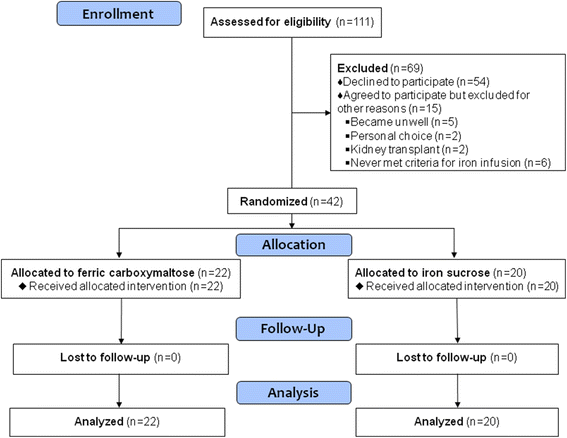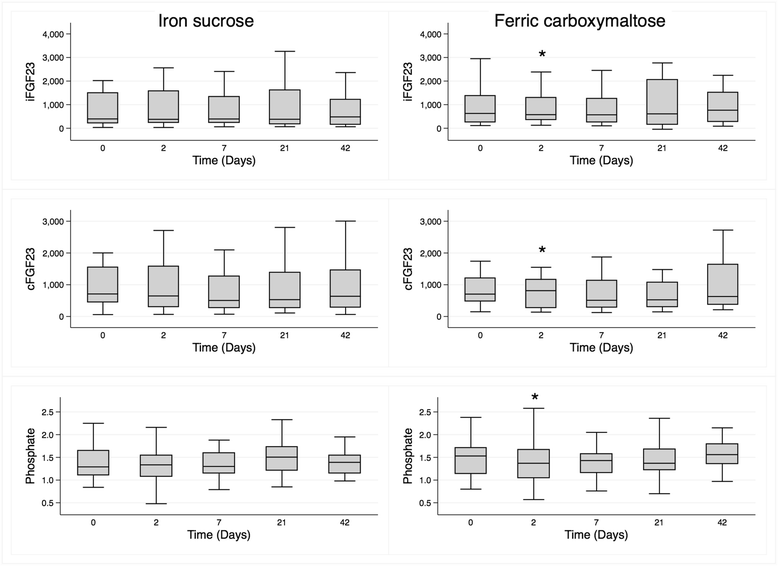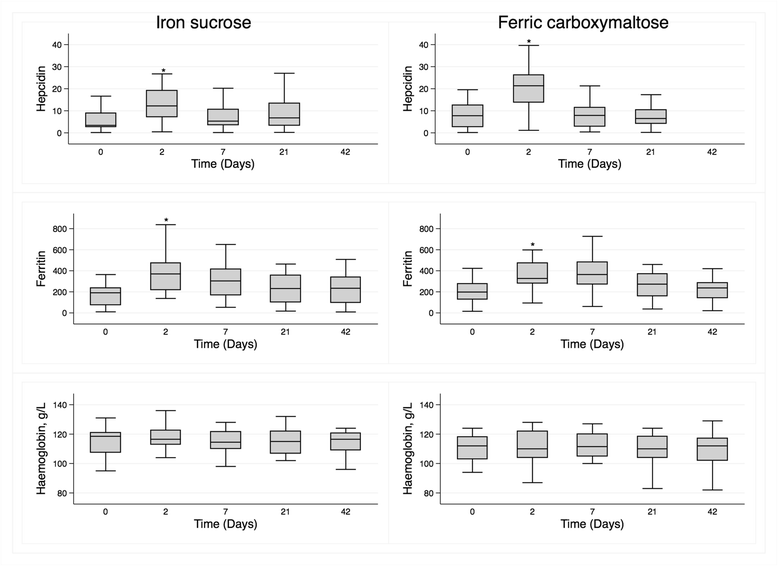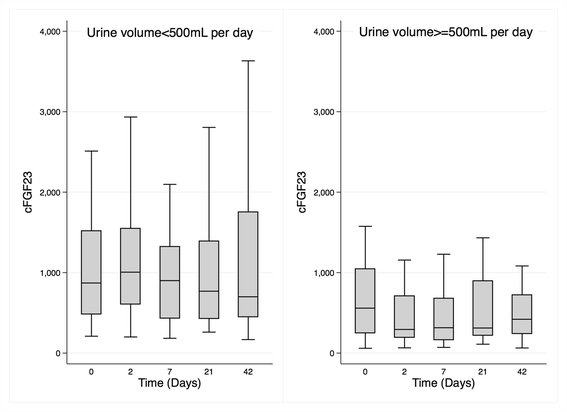Effects of intravenous iron on fibroblast growth factor 23 (FGF23) in haemodialysis patients: a randomized controlled trial
- PMID: 27852236
- PMCID: PMC5112660
- DOI: 10.1186/s12882-016-0391-7
Effects of intravenous iron on fibroblast growth factor 23 (FGF23) in haemodialysis patients: a randomized controlled trial
Abstract
Background: Intravenous iron affects serum levels of intact fibroblast growth factor-23 (iFGF23) and its cleavage product c-terminal FGF23 (cFGF23) in iron-deficient people with normal renal function. We hypothesized that intravenous iron modulates iFGF23 and cFGF23 in haemodialysis patients differently according to the type of iron used.
Methods: Prevalent, stable haemodialysis patients requiring protocol-based intravenous iron therapy were randomized to a single 200 mg dose of either ferric carboxymaltose (FCM) or iron sucrose (IS). The primary outcome was change in iFGF23 and cFGF23 from pre-infusion to Day 2 post-infusion. Serum hepcidin, ferritin and phosphate were also measured. Pair-wise comparisons utilised the Wilcoxon rank sum test; linear mixed models with an interaction term for treatment and time evaluated between-group effects.
Results: Forty-two participants completed the study. In those randomized to FCM (n = 22), median (interquartile range) values pre-infusion and Day 2, respectively, were 843 pg/mL (313-1922) and 576 pg/mL (356-1296, p = 0.05) for iFGF23, 704RU/mL (475-1204) and 813RU/mL (267-1156, p = 0.04) for cFGF23, and 1.53 mmol/L (1.14-1.71) and 1.37 (1.05-1.67, p = 0.03) for phosphate. These parameters did not change following IS. Both serum ferritin (p < 0.001) and hepcidin (p < 0.001) increased in both groups, and the increase in hepcidin was greater in the FCM group (p = 0.03 for between-group difference).
Conclusions: Contrary to iron-deficient people with normal renal function, haemodialysis patients given protocol-driven intravenous FCM demonstrated a fall in iFGF23 and a rise in cFGF23, changes not evident with IS. This suggests a differential effect of intravenous iron treatment according to both formulation and renal function.
Trial registration: Australian and New Zealand Clinical Trials Register ACTRN12614000548639 . Registered 22 May 2014 (retrospectively registered).
Keywords: Fibroblast growth factor-23; Haemodialysis; Hepcidin; Iron infusion; Randomized controlled trial.
Figures




Similar articles
-
Parenteral iron polymaltose changes i:c-terminal FGF23 ratios in iron deficiency, but not in dialysis patients.Eur J Clin Nutr. 2017 Feb;71(2):180-184. doi: 10.1038/ejcn.2016.217. Epub 2016 Nov 16. Eur J Clin Nutr. 2017. PMID: 27848940
-
A controlled study of the effects of ferric carboxymaltose on bone and haematinic biomarkers in chronic kidney disease and pregnancy.Nephrol Dial Transplant. 2018 Sep 1;33(9):1628-1635. doi: 10.1093/ndt/gfx310. Nephrol Dial Transplant. 2018. PMID: 29165637 Clinical Trial.
-
Effects of iron deficiency anemia and its treatment on fibroblast growth factor 23 and phosphate homeostasis in women.J Bone Miner Res. 2013 Aug;28(8):1793-803. doi: 10.1002/jbmr.1923. J Bone Miner Res. 2013. PMID: 23505057 Clinical Trial.
-
Use of intravenous iron supplementation in chronic kidney disease: an update.Iran J Kidney Dis. 2013 Jan;7(1):9-22. Iran J Kidney Dis. 2013. PMID: 23314137 Review.
-
Iron Treatment Strategies in Nondialysis CKD.Semin Nephrol. 2016 Mar;36(2):99-104. doi: 10.1016/j.semnephrol.2016.02.003. Semin Nephrol. 2016. PMID: 27236130 Review.
Cited by
-
The Role of DMP1 in CKD-MBD.Curr Osteoporos Rep. 2021 Oct;19(5):500-509. doi: 10.1007/s11914-021-00697-5. Epub 2021 Jul 31. Curr Osteoporos Rep. 2021. PMID: 34331667 Review.
-
Iron-based phosphate binders: a paradigm shift in the treatment of hyperphosphatemic anemic CKD patients?J Nephrol. 2017 Dec;30(6):755-765. doi: 10.1007/s40620-017-0421-y. Epub 2017 Jul 17. J Nephrol. 2017. PMID: 28717990 Review.
-
Hypophosphataemia, fibroblast growth factor 23 and third-generation intravenous iron compounds: a narrative review.Drugs Context. 2021 Jan 19;10:2020-11-3. doi: 10.7573/dic.2020-11-3. eCollection 2021. Drugs Context. 2021. PMID: 33519940 Free PMC article. Review.
-
Interpretation of the Kidney Disease: Improving Global Outcomes guidelines for iron therapy: commentary and emerging evidence.Clin Kidney J. 2017 Dec;10(Suppl 1):i3-i8. doi: 10.1093/ckj/sfx042. Epub 2017 Nov 28. Clin Kidney J. 2017. PMID: 29225817 Free PMC article. Review.
-
Hypophosphataemia after treatment of iron deficiency with intravenous ferric carboxymaltose or iron isomaltoside-a systematic review and meta-analysis.Br J Clin Pharmacol. 2021 May;87(5):2256-2273. doi: 10.1111/bcp.14643. Epub 2020 Dec 7. Br J Clin Pharmacol. 2021. PMID: 33188534 Free PMC article.
References
-
- Isakova T, Xie H, Yang W, Xie D, Anderson AH, Scialla J, Wahl P, Gutierrez OM, Steigerwalt S, He J, et al. Fibroblast growth factor 23 and risks of mortality and end-stage renal disease in patients with chronic kidney disease. JAMA. 2011;305(23):2432–9. doi: 10.1001/jama.2011.826. - DOI - PMC - PubMed
-
- Farrow EG, Yu X, Summers LJ, Davis SI, Fleet JC, Allen MR, Robling AG, Stayrook KR, Jideonwo V, Magers MJ, et al. Iron deficiency drives an autosomal dominant hypophosphatemic rickets (ADHR) phenotype in fibroblast growth factor-23 (Fgf23) knock-in mice. Proc Natl Acad Sci. 2011;108(46):E1146–55. doi: 10.1073/pnas.1110905108. - DOI - PMC - PubMed
Publication types
MeSH terms
Substances
Associated data
LinkOut - more resources
Full Text Sources
Other Literature Sources
Medical

